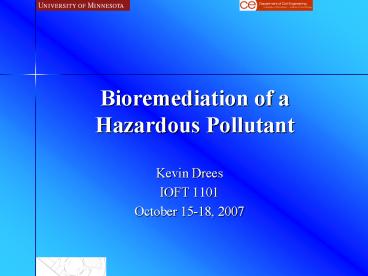Bioremediation of a Hazardous Pollutant - PowerPoint PPT Presentation
1 / 18
Title:
Bioremediation of a Hazardous Pollutant
Description:
Burning leaded gasoline. Old paint (Lead) Common Pollutants ... Can be in-situ. Inject nutrients organisms need to degrade pollutant into contaminated area ... – PowerPoint PPT presentation
Number of Views:501
Avg rating:3.0/5.0
Title: Bioremediation of a Hazardous Pollutant
1
Bioremediation of a Hazardous Pollutant
- Kevin Drees
- IOFT 1101
- October 15-18, 2007
2
What are hazardous pollutants?
- Misplaced chemicals that cause a harmful effect
in the environment - Types of harmful effects
- Toxic (poisonous)
- Carcinogenic
- Mutagenic
- Teratogenic (birth defects)
- Flammable
- Corrosive
- Explosive
- Endocrine Disruptive
3
Common Pollutants
- Petrochemicals
- Hydrocarbons (only carbon and hydrogen)
- Mostly alkanes
- Oil spills
- Leaky underground storage tanks
- Coal tar
CH3 (CH2)n CH3
4
Common Pollutants
- PCE (perchloroethylene),
- TCE (trichloroethylene)
- Common drycleaning chemical
- Most common groundwater pollutant
- Used to clean circuit boards and degrease engine
parts - Common pollutant at electronics factories,
airports, and military facilities
5
Common Pollutants
- Heavy metals
- Mercury, Lead, Cadmium, Chromium, Zinc
- Mine tailings
- Burning coal (Mercury)
- Burning leaded gasoline
- Old paint (Lead)
6
Common Pollutants
- Polychlorinated Biphenyls (PCBs)
- Transformer fluid
- Capacitor manufacture
- Pulp bleaching
- Bioaccumulates!
7
Where is the pollution?
- Groundwater aquifers
- Soil
- Surface waters and sediment
- Air
8
How do we clean up pollution?
- Remediation
- Ex-situ (off-site) strategies
- Excavation/pumping, followed by
- Landfill
- Incineration
- Chemical removal
- In-situ (on-site) strategies
- Immobilization (chemicals, wells, membranes)
9
Problems with traditional remediation
- Expensive!!!
- Invasive
- Residual contamination
- Landfilling not a permanent solution, just a
delay tactic
10
Bioremediation
- Bacteria eat or immobilize many types of
pollutants - Bioremediation using bacteria to degrade or
immobilize pollutants - Can be in-situ
- Inject nutrients organisms need to degrade
pollutant into contaminated area - Can be ex-situ
- Excavate soil, pump water into bioreactor
- Can use indigenous microbes, or introduce them
11
Advantages of Bioremediation
- Cheap
- Less invasive
- Long-term
- Can handle residual contamination
12
How do bacteria degrade pollutants?
- All organisms need several things to live
- Chemical building blocks (containing C, N, P, O,
S) - Energy to power cell biochemical reactions
- Breaking chemical bonds in food
- Method of recycling energy-producing molecules
- Ex respiration (oxygen)
- Vitamins and minerals
- Active sites of enzymes
- Pollutants can serve as one or many of these
requirements!
13
Ex Petroleum Degradation
- Petroleum provides carbon building blocks for
cells. - In addition, cells require
- Nitrogen, phosphorous, and other nutrients
- Oxygen
CH3 (CH2)n CH3
14
Todays Lab
- Create oil-contaminated microcosms
- Sand, water, and oil in a Petri dish
- Introduce petroleum-degrading bacterium
- Achromobacter sp. ATCC 21910
- Isolated from a crude oil-contaminated beach
- Introduce nutrients the bacteria need to degrade
the oil - Fertilizer (NH4NO3, K2HPO4)
- Carefully observe your microcosms, now and next
week. - Smell, appearance
15
Experimental Setup
Dish Sand (30 gm) Oil (10 drops) Water Fertilizer (1 ml) Bacteria (1 ml)
1 X X 8 ml X X
2 X X 9 ml X
3 X X 9 ml X
4 X X 10 ml
16
Procedure
- Label top and bottom of Petri dish with treatment
number, lab group number, lab time. - Weigh out 30 g sand into each dish
- Clean up any spilled sand!
- Add fertilizer, bacteria, oil at stations.
- Add water using graduated cylinder
- Stir sand well with glass rod.
- Clean glass rod with ethanol and a tissue between
dishes! - Make observations
- Leave completed microcosms on your bench. Your
TA will put them in the 30C incubator
17
Safety Issues
- Oil is toxic. Avoid contact.
- Achromobacter sp. ATCC 21910 is related to a
pathogen. - Wear labcoats, gloves, safety glasses.
- Avoid spilling/dripping bacterial culture
- Alert TA in the event of a spill, on the bench or
your lab coat - Wipe benches down, BEFORE AND AFTER, with
disinfectant solution. - Wash your hands!
18
Questions?































